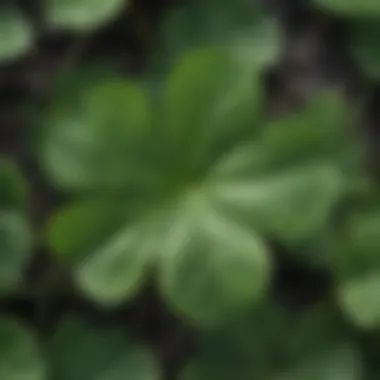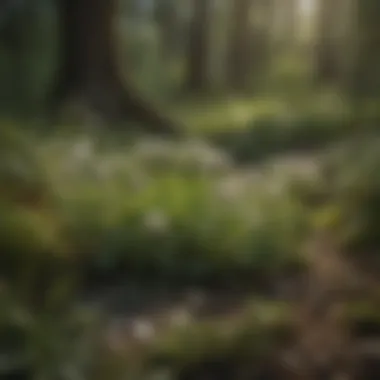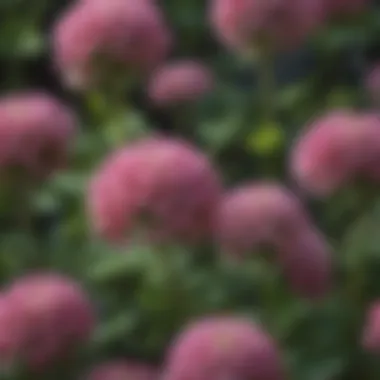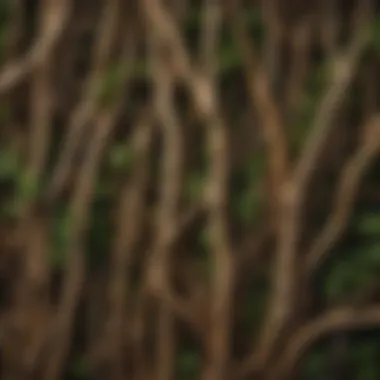A Comprehensive Guide to Clover Identification


Intro
Clover serves various roles in the ecosystem, from being a decorative ground cover to a source of nourishment for bees and other pollinators. Many people appreciate clover for its lush greenness and effective nitrogen-fixing abilities. However, some species can become invasive, leading to unwanted growth in gardens or yards. This guide aims to unravel the complexities of clover identification, offering insights into its numerous varieties and encouraging better management practices.
Understanding clover requires knowledge about its identification and life cycle. Being able to distinguish between beneficial species and those that could be disruptive is essential for gardeners and householders alike. We aim to provide a structured approach to clover identification, enabling readers to recognize these plants effectively in their environments.
In this guide, you will find various methods to identify clover, understand its life cycle, and learn practical approaches for preventing its spread. Clover identification can empower gardeners to appreciate these plants or contain them when necessary. Let’s delve into the details that matter the most in understanding clover and its role in the local environment.
Preamble to Clover Identification
Clover plays a crucial role in various ecosystems. The ability to identify different clover species not only empowers gardeners but also informs pest management strategies. This section will unfold the significance of clover identification while exploring the characteristics that define each species. It is particularly beneficial for housewives and homeowners who wish to cultivate gardens that are both aesthetically pleasing and functional.
Importance of Clover in Ecosystems
Clover serves as a vital component in many ecosystems due to its ability to fix nitrogen. This characteristic enriches the soil, promoting healthier plant growth. Many gardeners appreciate clover for its role as a cover crop. It prevents soil erosion, suppresses weeds, and enhances overall biodiversity. Additionally, clover attracts beneficial insects like bees, which are essential for pollination.
The presence of clover can also enhance the habitat for other wildlife. Birds and small mammals benefit from its seeds. Furthermore, clover often provides food for livestock, enhancing agricultural sustainability. Cultivating clover is, thus, a practice that supports natural ecosystems while providing tangible benefits to the gardener.
Clover Species Overview
Understanding clover species is fundamental for accurate identification. There are numerous types of clover, each exhibiting distinct features and growth habits. The most common species include White Clover, Red Clover, Crimson Clover, and Yellow Clover. Each species varies in terms of physical characteristics, habitat preferences, and uses.
- White Clover: Renowned for its low growth and white flowers, it is often found in lawns and gardens.
- Red Clover: Typically taller with round purple flowers, it is favored for its forage qualities and popular in some herbal remedies.
- Crimson Clover: Recognizable by its red conical petals, it is effective as a cover crop due to its fast establishment.
- Yellow Clover: With yellow flowers, it may be less common but still plays a role in soil health.
Identifying the right clover species is vital for maximizing their benefits in gardens. By recognizing features such as leaf shape, flower color, and growth habits, homeowners can improve garden diversity and health.
Botanical Characteristics of Clover
Understanding the botanical characteristics of clover is essential for accurate identification and effective utilization of these plants in various applications. Clover species present distinct physical traits that not only distinguish one variety from another but also highlight their adaptability to different environments. By focusing on specific elements such as foliage shapes and sizes, flower structures and colors, and growth habits and propagation methods, gardeners and pest control professionals can make informed decisions when managing their landscapes or gardens.
Foliage Shapes and Sizes
The leaf structure of clover plays a significant role in its identification. Most clovers have trifoliate leaves, meaning each leaf comprises three leaflets. The shape of these leaflets varies between species. For example, the white clover (Trifolium repens) features oval leaflets, whereas the red clover (Trifolium pratense) presents broader, longer leaflets. Additionally, the coloration and patterns of the leaves can provide further clues about the species. Some clovers, like the white clover, display a distinctive white "W" mark on the leaflets, aiding in quick visual identification.
The size of clover leaves also varies, depending on the species and growing conditions. Generally, leaflets can range from about 1 to 5 centimeters in length. Recognizing these subtle differences is crucial for anyone interested in distinguishing clover species.
Flower Structures and Colors
Clover’s flowers are often a key identification feature. The blossoms typically grow in dense, spherical clusters, which vary significantly in color. White clover has small white to off-white flowers, while red clover sports rich pink to purple hues. Crimson clover (Trifolium incarnatum), characterized by its vivid red flowers, can often be found in fields and meadows.
Flower structures also vary, with each species presenting unique characteristics. For example, the flowers of white clover are relatively smaller and have more elongated petals. In contrast, red clover’s flowers are larger and full, making them easily noticeable in a garden or lawn.
The flowering season is another key consideration. Most clover species bloom in late spring and summer. Identifying the bloom time can assist in recognizing the specific clover species when other characteristics are not readily visible.
Growth Habits and Propagation


Clover plants possess diverse growth habits that may influence how they are used in landscaping and agricultural practices. Some species, like the white clover, spread through both seeds and vegetative means, forming dense mats on the ground. In contrast, red clover primarily propagates through seeds, establishing itself in more specialized conditions.
Considering the growth habits is important, especially in terms of managing clover as a potential cover crop. Clover can improve soil fertility and structure due to its ability to fix nitrogen. Therefore, understanding the growth patterns can help in implementing effective agricultural strategies that maximize benefits while mitigating the risks of overgrowth.
In summary, the botanical characteristics of clover play a crucial role in identifying the various species. Understanding their foliage shapes, flower structures, and growth habits enables gardeners and landscape managers to utilize clover more effectively, whether for aesthetic purposes or ecological benefits.
Key Clover Species and Identification Tips
Identifying different clover species is essential for gardeners and pest management professionals. These plants have unique characteristics that help in their classification and understanding their ecological roles. By familiarizing oneself with identification tips, gardeners can enhance their planting strategies and manage pest populations effectively. Let’s look into some of the key species of clover and their identifying features, habitat preferences, and common uses.
White Clover
Identification Features
White Clover, known scientifically as Trifolium repens, is identifiable by its round leaflets typically marked by a white crescent. This unique feature makes it easy to spot in various landscapes. Unlike other clovers, its lower growth habit allows it to spread rapidly along the ground. This characteristic not only makes it popular in lawns, but also aids in erosion control, increasing its overall utility in diverse gardening scenarios.
Habitat Preferences
White Clover thrives in well-drained soils, favoring areas with partial sun to full sunlight. It does well in temperate climates, adapting easily to disturbed soils. This adaptability is a huge benefit for gardeners looking to establish a resilient ground cover. In residential landscapes, it can fill in bare patches and improve soil fertility through nitrogen fixation, although in agro-ecosystems, it may compete with more desirable plant species.
Common Uses
This species is commonly used as forage for livestock due to its high protein content. Additionally, it is valued in lawns for its ability to withstand foot traffic, thanks to its creeping nature. Nevertheless, some gardeners might find that its rapid spread can lead to unwanted encroachment into flower beds or vegetable gardens.
Red Clover
Identification Features
Red Clover, or Trifolium pratense, has distinctive pinkish-purple flowers that are arranged in dense clusters. The leaves are broad and marked with a reddish tinge, enhancing their recognition. This species has a more upright growth habit compared to its white counterpart. Its beautiful flowers attract pollinators, making it a beneficial choice for those interested in supporting local ecosystems.
Habitat Preferences
This clover is versatile but prefers fertile, moist soils. It can grow in full sun or partial shade, which further adds to its appeal for gardens with varying light conditions. However, its preference for rich soil presents a challenge. In less nutrient-dense areas, Red Clover may struggle to thrive, so soil amendments might be necessary for optimal growth.
Common Uses
Outside of its ornamental value, Red Clover is traditionally used in herbal medicine for its purported health benefits. Its ability to enhance soil quality through nitrogen fixation makes it a preferred choice for crop rotation. However, its proclivity for moisture may cause issues in overly wet environments, possibly leading to root rot.
Crimson Clover
Identification Features
Crimson Clover, scientifically known as Trifolium incarnatum, is recognized by its striking deep red flowers that stand tall on slender stems. This feature makes it particularly aesthetic for gardens. The leaves are typically trifoliate but can vary slightly in size. Its vivid flower clusters provide a significant visual impact in blooming gardens.
Habitat Preferences
This clover is well-adapted to well-drained, sandy soils and prefers sunny locations. Its preference for slightly drier conditions makes it suitable for areas that might not be ideal for other clover species. This characteristic helps gardeners manage water usage effectively.


Common Uses
Crimson Clover is often utilized as a cover crop because of its ability to suppress weeds and enhance soil structure. Its flowers are effective in attracting pollinators. However, in severe dry conditions, it may fail to establish properly, requiring careful planning regarding irrigation.
Yellow Clover
Identification Features
Yellow Clover, or Trifolium aureum, presents a more compact appearance with its yellow flowers. This species can be identified by its smaller leaves and flowers compared to others. It has a bushier growth pattern, making it suitable for edges of flower beds, enhancing distortion-free lines in gardens.
Habitat Preferences
It tends to prefer acidic soils and can tolerate a range of environmental conditions but thrives best in cooler climates. This can be advantageous for gardeners in specific geographical areas. However, it may not do as well in nutrient-poor soils, showcasing its requirement for balanced fertility.
Common Uses
Yellow Clover is known to be an excellent green manure crop, providing organic matter to the soil. It is sometimes overlooked compared to more popular clover species. Despite this, the unique beauty of its flowers can bring a different aesthetic element to a garden space.
Clover and Its Role in Pest Management
Clover plays a significant role in integrated pest management strategies. This herbaceous plant not only contributes to biodiversity but also provides various benefits that can enhance gardening practices and crop yields. Understanding how clover fits into pest management is vital for those interested in sustainable gardening and landscaping.
Clover as a Beneficial Plant
Clover offers numerous advantages for both the ecosystem and the gardener. It is well known for its ability to fix nitrogen in the soil. This improvement in nitrogen levels benefits surrounding plants, making clover a popular choice for cover cropping. Growing clover can enhance soil fertility naturally, promote healthier plant growth, and reduce the need for chemical fertilizers.
Additionally, clover attracts beneficial insects such as pollinators and predators of pests. Bees, for instance, are drawn to clover flowers, which aids in pollination for nearby crops. These insects help in maintaining ecological balance by controlling pest populations, further supporting sustainable garden practices.
Moreover, clover can suppress weed growth. By establishing a dense mat, clover offers competition to weeds, reducing their chance to thrive. This suppression not only keeps gardens tidy but also minimizes the need for herbicides, making it an eco-friendly choice.
"Clover enhances biodiversity and promotes sustainable gardening practices."
Potential Pest Issues Associated with Clover
While clover has numerous beneficial aspects, it can also attract certain pests that may pose challenges. For example, some plant bugs and aphids find clover appealing, which could lead to infestations. These pests may transition to nearby plants, causing potential damage to crops and ornamental plants.
Another consideration is the clover root curculio, a beetle that can harm clover roots and affect overall plant health. Although these pests can affect clover’s vitality, they also highlight the importance of maintaining careful observations in gardens where clover is grown.
In terms of management, regular monitoring of clover and surrounding plants can help detect any emerging pest issues early. Utilization of organic pest management practices, rather than resorting to chemical interventions, can mitigate potential problems effectively.
Environmental Factors Affecting Clover Growth
Understanding environmental factors that influence clover growth is essential for optimal cultivation. These factors include soil conditions and climate preferences. Knowing these can greatly enhance the plant's health, yield, and adaptability. Moreover, gardeners can make informed decisions about care and management. This section will elaborate on how these factors affect clover and their broader implications for gardening practices.
Soil Conditions
The soil in which clover is planted plays a vital role in its growth. Ideal soil has good drainage and is rich in organic matter. pH levels should typically range from 6.0 to 7.5, which supports nutrient availability.


- Soil Type: Clover thrives in loamy soils. Clay-heavy or sandy soils can hinder growth. Knowing the soil texture helps in selecting the best clover species for your garden.
- Nutrient Content: Nutrient-rich soils enhance clover's growth potential. Key nutrients like nitrogen, phosphorus, and potassium contribute significantly to plant health. Soil testing can help in assessing these nutrients.
- Moisture Retention: While clover is somewhat drought-resistant, consistent moisture promotes vigorous growth. Organic matter can improve soil structure, enhancing its capacity to retain moisture.
Climate Preferences
Clover is adaptable but has specific climate preferences that contribute to its growth. Generally, it flourishes in temperate regions with distinct seasons.
- Temperature: Optimal temperatures for clover growth range from 60°F to 75°F. Extreme cold or prolonged heat can stress the plants, leading to diminished growth.
- Sunlight Requirements: Clover prefers full sunlight but can tolerate partial shade. Adequate sunlight ensures robust photosynthesis, impacting overall health.
- Rainfall: Regular rainfall supports clover growth. However, excessive rainfall can lead to root rot, stressing the plant. Gardeners must consider local rain patterns when planting.
"Understanding these climatic factors is crucial for successful clover identification and management."
Clover Management Practices
Clover management practices are crucial for optimizing growth and ensuring plant health. Effective management not only enhances the vitality of the clover but also contributes positively to the surrounding ecosystem. For gardeners and homeowners, understanding and implementing the right techniques can lead to a more productive environment. This section elucidates significant elements of clover management, emphasizing the benefits and key considerations involved.
Maintenance Techniques for Healthy Growth
Healthy growth of clover is achieved through meticulous maintenance practices. Here are some essential techniques:
- Soil Preparation: Start with a well-drained, nutrient-rich soil. Prior to planting, conduct a soil test to determine pH. Clover generally thrives in slightly acidic to neutral soils (around 6.0 to 7.0).
- Seeding Rate and Timing: Optimal seeding rates depend on the species of clover. Generally, a rate of 6 to 8 pounds per acre is suitable for red clover. Early spring or late summer is the best timing for seeding.
- Watering: Clover prefers moderate moisture levels. Ensure the soil remains moist but not waterlogged, especially during germination stages.
- Fertilization: While clover is a nitrogen-fixing plant, additional phosphorus and potassium may enhance growth. Apply fertilizers as directed based on soil health assessments.
- Mowing: Regular mowing can prevent weed overgrowth and promote sturdiness in plant structure. Mow when clover reaches a height of about 8 inches and leave some for regrowth.
These practices not only enhance the aesthetic aspect but also reinforce the adaptability of clover in various environmental conditions.
Identifying and Managing Common Pests
Pests can pose a significant threat to clover health. Here are some common pests and strategies for managing them:
- Aphids: These small, soft-bodied insects can weaken clover plants. They may be controlled using insecticidal soap or by introducing natural predators like ladybugs.
- Spider Mites: Look for stippling on the leaves. Maintaining adequate humidity can deter them. Regularly spraying the plants with water is helpful.
- Clover Root Boring Beetles: The larvae damage roots. Crop rotation and maintaining healthy soil can reduce their occurrence.
- Weeds: While not insects, weeds compete for nutrients. Implement mulching and manual removal as effective control methods.
Management requires consistent observation. > Regularly inspecting plants for signs of infestation is key to early detection and control.
By employing these management practices, gardeners can maintain a thriving clover population, supporting its role in the ecosystem while enjoying vivid patches of green in their landscapes.
The End and Future Perspectives on Clover Identification
Understanding clover and its identification holds significant importance for gardeners and pest control professionals alike. Effective clover identification aids in recognizing its role in various ecosystems and promotes better management practices. This section explores the conclusion on the relevance of clover identification, along with potential future research directions.
Summary of Key Points
The discussion on clover identification has revealed several key points:
- Biodiversity: Clover species provide important ecological functions. They contribute to soil fertility and support various wildlife.
- Identification Process: Recognizing distinct clover species involves understanding their foliage shapes, flower structures, and growth habits. Each species presents unique features that aid in accurate identification.
- Management Practices: Implementing proper management techniques can enhance clover's benefits while minimizing pest issues associated with them.
By summarizing these points, it is clear that clover serves as both a beneficial plant and a potential pest within ecosystems.
Emerging Research in Clover Studies
Future research in clover studies is promising and vital. Scientists are focusing on various aspects:
- Genetic studies: These studies aim to understand the genetic diversity among clover species, which may provide insights into their adaptability and resilience.
- Ecological Impact: Learning how clover affects soil health, interacts with other plants, and influences pest dynamics can enhance sustainable agricultural practices.
- Integration with Technology: The application of technology such as remote sensing could improve the monitoring and management of clover populations.
Ongoing research can lead to improved identification strategies and better practices for utilizing clover in ecological management.
"Clover is more than just a plant; it's a crucial component of our ecosystems. Understanding it fully is essential."







